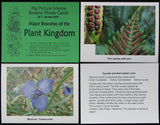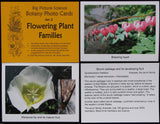The Big Picture for Botany, Part 2 June 15 2015, 0 Comments
I’m continuing on my commentary about my botany materials and how to choose them, this time with emphasis on the older elementary child.
 Children in the 9-12 year-old range have different needs than the younger elementary ones, so they are not likely to find the little booklets and three-part cards of Illustrated Botany for Children attractive. They can, however, use the wall charts (summary charts) from that material to review or to check on terminology. The file for printing the wall charts by themselves is available. See http://big-picture-science.myshopify.com/collections/montessori-botany-materials/products/illustrated-botany-for-children-wall-charts-only
Children in the 9-12 year-old range have different needs than the younger elementary ones, so they are not likely to find the little booklets and three-part cards of Illustrated Botany for Children attractive. They can, however, use the wall charts (summary charts) from that material to review or to check on terminology. The file for printing the wall charts by themselves is available. See http://big-picture-science.myshopify.com/collections/montessori-botany-materials/products/illustrated-botany-for-children-wall-charts-only
If you have my book, Plant Lessons: Introducing Children to Plant Form and Function, you have a number of lesson avenues to further botany studies. If your children have had the basics, then you can go deeper into flower structure, plant adaptations, fruits, and seed structure and function.

If you are basing your botany studies on flowering plant families (an excellent way to structure botany), then you have lots of interesting botany yet to cover. Even if children studied a flowering plant family each month in their three earlier years of elementary, that is only 27 families out of over a hundred that might be found in temperate North America, either as natives or imported ornamentals or as food plants. The total count of angiosperm families is 413 in the last official publication. The number of families that you may experience will depend on the continent on which you reside, and on your local climate and growing conditions. The tropics have a much greater diversity than temperate areas. If children have not studied flowering plant families before, they can dig into them at upper elementary level.
 Photo card set 2, Flowering Plant Families, is an introduction to 14 flowering plant families. The photos each have text on the back to start children’s research about these lineages. The families are a sampling across the major lineages of angiosperms. The efile of my PowerPoint presentation on flowering plant families, designed first for adult botany education, is available as a download. This pdf shows 20 families, eleven of which are not in photo card set 2. The PowerPoint slides are illustrated with color photos, and the pdf is at sufficient resolution for printing. Purchasers have the right to print the slides, but only for their own classroom. The slides can serve as research starters, although the photo cards have more information, and the text is in complete sentences vs. the phrases on the slides.
Photo card set 2, Flowering Plant Families, is an introduction to 14 flowering plant families. The photos each have text on the back to start children’s research about these lineages. The families are a sampling across the major lineages of angiosperms. The efile of my PowerPoint presentation on flowering plant families, designed first for adult botany education, is available as a download. This pdf shows 20 families, eleven of which are not in photo card set 2. The PowerPoint slides are illustrated with color photos, and the pdf is at sufficient resolution for printing. Purchasers have the right to print the slides, but only for their own classroom. The slides can serve as research starters, although the photo cards have more information, and the text is in complete sentences vs. the phrases on the slides.
 Photo card set 3, 48 Flowers for Study and Sorting, can be used with many levels of students. This set has examples of a wide variety of flower features, and includes a table to help teachers pick the right cards for a variety of lessons, from simple naming of flowers to details of their structure. While younger children will likely be sorting the pictures, upper elementary and secondary students can use the accompanying text cards to learn more about the structural details and the lineages of the plants. For example, the photo that symbolizes this set is a flower of blue flax. It is a eudicot flower with distinct petals that shows radial symmetry. The text card tells that this plant is a member of the rosid lineage of eudicots, and of the fabid lineage of rosids. Its order and family are also given.
Photo card set 3, 48 Flowers for Study and Sorting, can be used with many levels of students. This set has examples of a wide variety of flower features, and includes a table to help teachers pick the right cards for a variety of lessons, from simple naming of flowers to details of their structure. While younger children will likely be sorting the pictures, upper elementary and secondary students can use the accompanying text cards to learn more about the structural details and the lineages of the plants. For example, the photo that symbolizes this set is a flower of blue flax. It is a eudicot flower with distinct petals that shows radial symmetry. The text card tells that this plant is a member of the rosid lineage of eudicots, and of the fabid lineage of rosids. Its order and family are also given.
How about structuring your botany around food plants? You could combine history of the plant’s domestication, botany of its flowers, and even include to culinary uses. The practical application of farming at middle school level is another layer of this study. Knowledge of flowering plant families can help with the planning of crop rotation and fertilizer applications.
Dig in! Enjoy the unfolding miracles of the plant kingdom that go on all around you.
